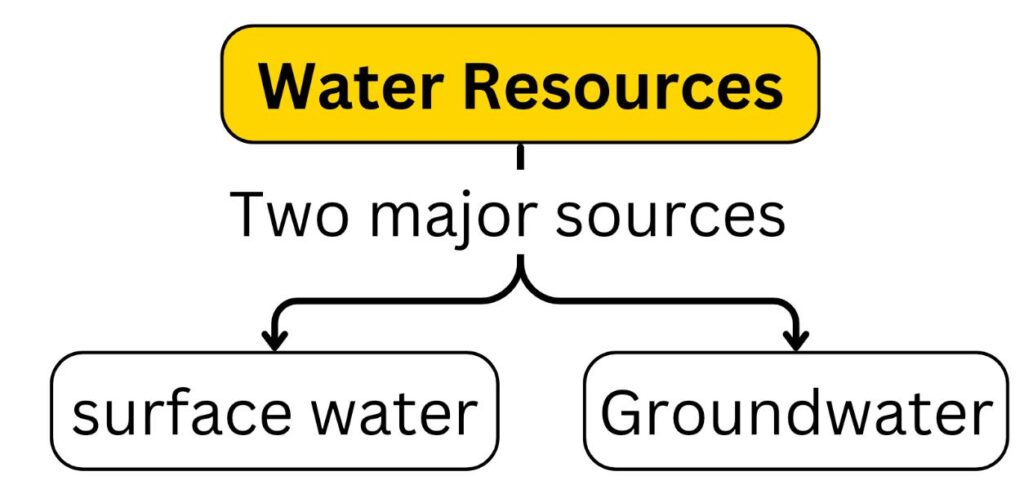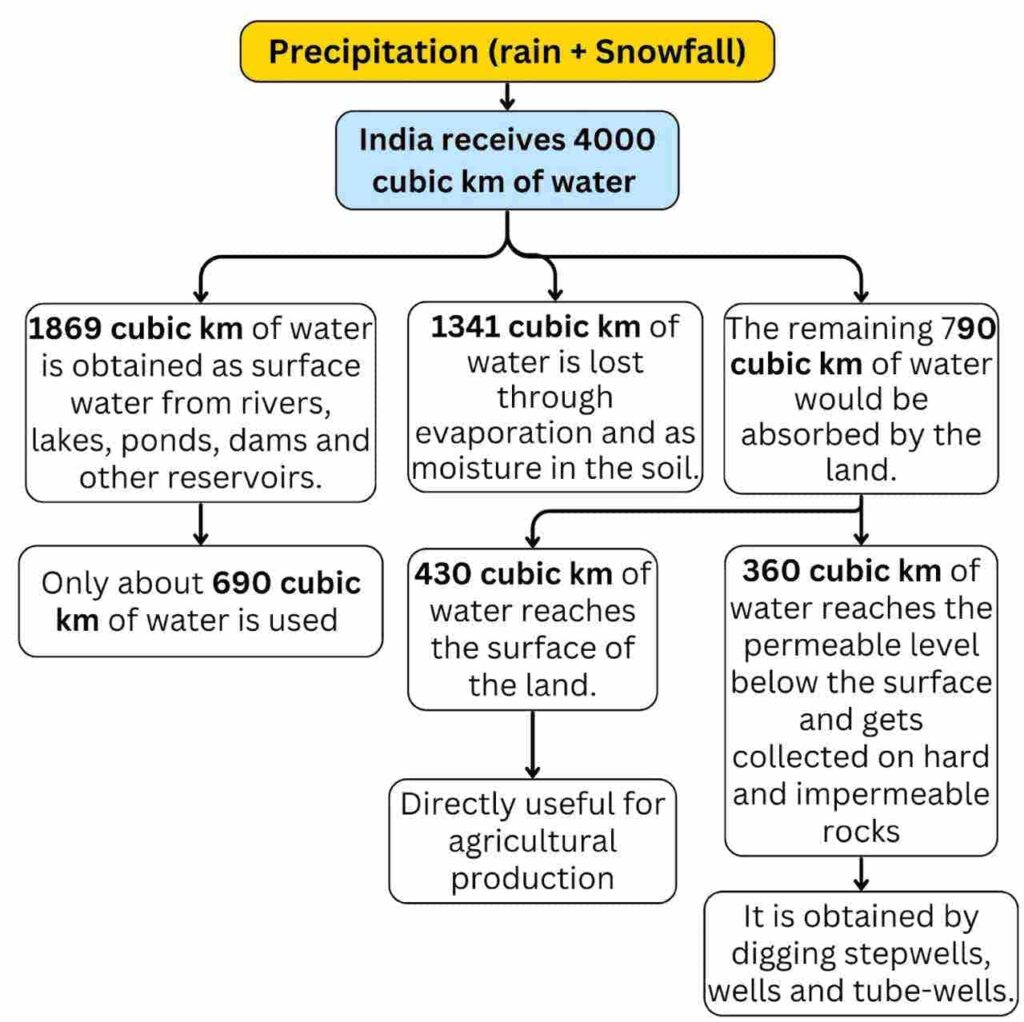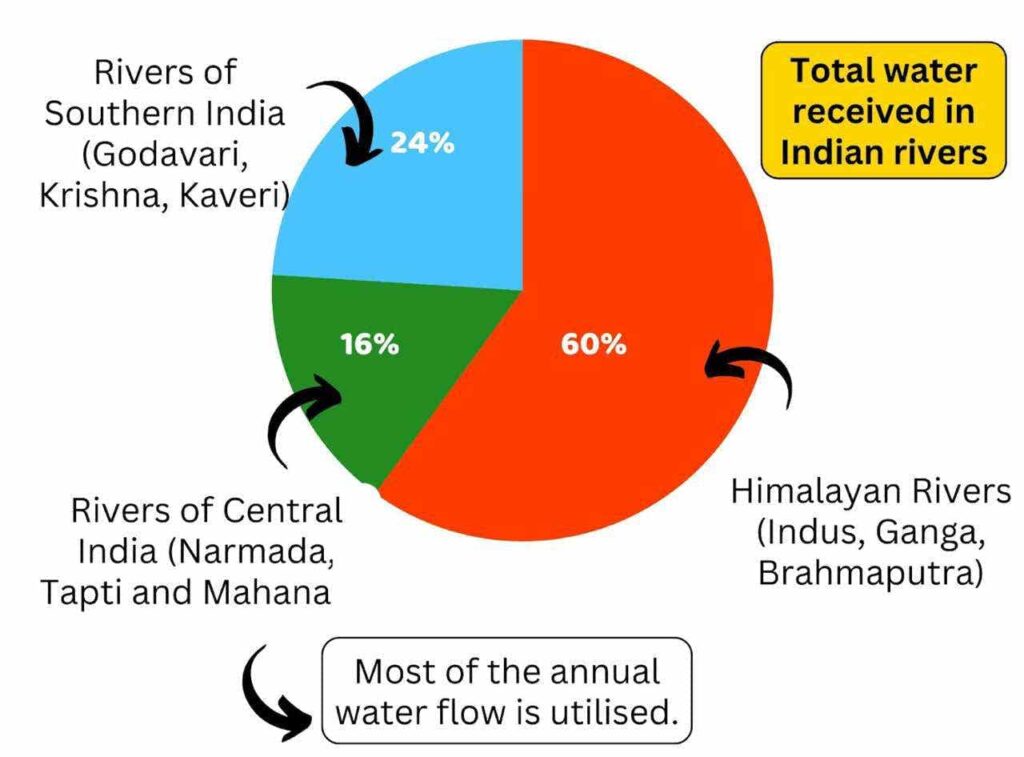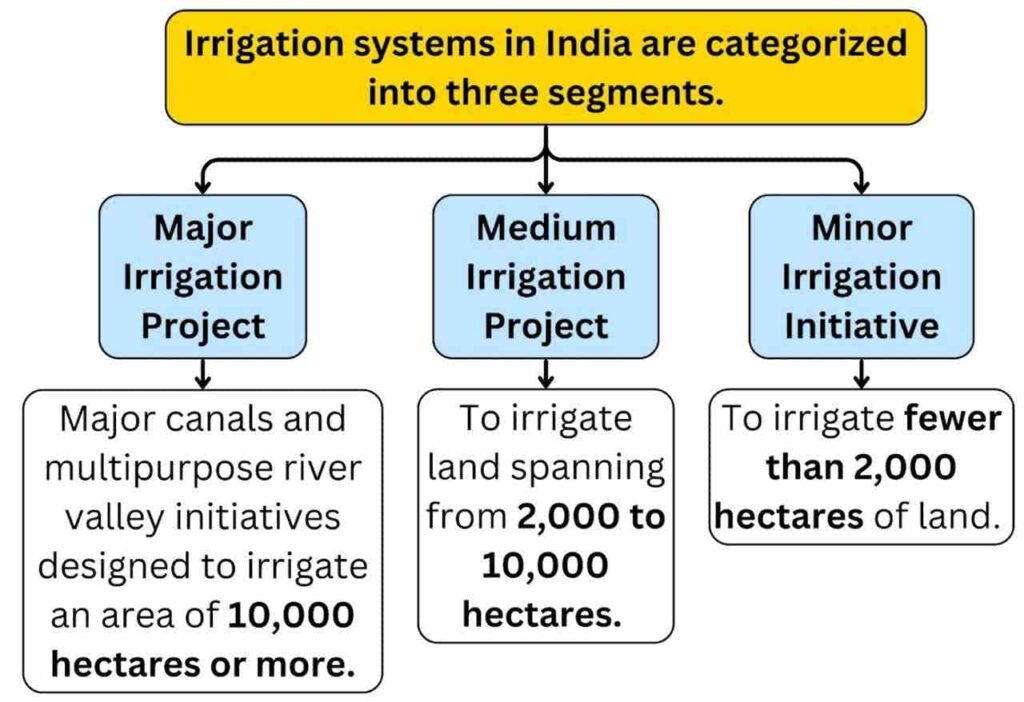In Indian Geography, water resources are critical to the nation’s sustenance, driving agriculture, industry, and domestic needs. Major rivers like the Ganges, Brahmaputra, and Godavari, along with groundwater and reservoirs, form the backbone of India’s water supply, shaping its socio-economic landscape.
General Introduction
- Water is a compound of hydrogen and oxygen. Water covers about 71 percent of the earth’s land surface, which includes oceans, seas, lakes, rivers, glaciers, etc.
- It is a major natural resource and valuable national asset that is a useful and basic necessity for the survival of humans, animals and plants.

- India has about 2.45% of the world’s land area, 4% of water resources, and about 17% of the population.
- The total amount of water received from precipitation in a year in the country is about 4,000 cubic km.
- The total usable water resources in the country are 1,122 cubic km.
Water crisis – Per capita annual water availability ➞ If it is less than 1,700 cubic meters ( in india 1545 cubic metres in 2011), then there is a water crisis and if it is less than 1,000 cubic meters, then there is a situation of water scarcity. India is in a state of water crisis, where there is inequality at the regional level due to geographical and climatic variations.
According to the report of the 15th Finance Commission, about 60 crore Indians were facing high or extreme water crisis in 2020.

Surface Water Resources
- 4 main sources of surface water – rivers, lakes, pools and ponds.
- Plains rivers are especially useful for irrigation and drinking water. According to official data, more than 50% of the country’s irrigated area comes under Uttar Pradesh, Punjab and Tamil Nadu.
- Rivers flowing from the mountainous regions of the Himalayas and the peninsular plateau are especially important for hydroelectricity production. Various multipurpose projects are being run on these rivers.
Rainfall – It is the main source of water. In India, 32.87 lakh sq km of land area receives an average rainfall of 108 cm per year.

Note – The flow of water in a river depends on the size of its catchment area or river basin and the rainfall in this catchment area.

Use of surface water: Most of the use is for 89% agriculture work, 9% domestic work and 2% industrial work.
- India’s coastline is vast and partly disjointed. Therefore, many lagoon lakes have been formed in Kerala, Orissa and West Bengal. This water is used for fish farming, coconut and irrigation of some varieties of rice.
Ground Water Resources
- ‘Groundwater’ – the water that seeps through rocks and soil and gets stored in the lower layers of the earth’s surface.
- The development of groundwater has not happened uniformly in different parts of the country.
- It has also decreased due to overexploitation of groundwater for various purposes.
- The total replenishable groundwater resource in the country is about 447 cubic km. Out of the total 4000 cubic km of water received from rainfall in India, only 790 cubic km of water is obtained as underground water. Out of this, only 225 cubic km of water can be used economically. [For irrigation – only about 78 cubic km of underground water resource is used]
- Groundwater is used for most of the agriculture activities (92%), domestic activities (3%) and industrial activities (5%).
- Groundwater use is relatively high in the river basins of north-western region and some parts of southern India.
- Groundwater use is very high in the states of Punjab, Haryana, Rajasthan and Tamil Nadu. But some states like Chhattisgarh, Odisha, Kerala etc. use very little of their groundwater potential.
- Gujarat, Uttar Pradesh, Bihar, Tripura and Maharashtra are using their groundwater resources at a moderate rate.
Underground water resources are affected by many factors, which include climatic conditions, relief, geological structure and hydrological conditions. On the basis of these characteristics, India is mainly divided into eight underground water regions-
- Region of Pre-Cambrian crystalline rocks – spread over more than half of the country’s land area. Lack of water resources. [Tamil Nadu, Telangana, Andhra Pradesh, Dandakaranya region of Chhattisgarh, Bundelkhand, Rajasthan etc.]
- Pre-Cambrian Sedimentary Basin – spread over Cuddapah and Vindhyan basins. Lack of underground water resources.
- Gondwana Sedimentary Basin – includes Barakar, Damodar, Swarnarekha and Godavari basins. Adequate underground water resources available.
- Deccan Trap Region – Lack of underground water due to presence of impermeable basaltic rocks. [Areas of Maharashtra and Karnataka]
- Cenozoic Sedimentary Basin – Adequate underground water due to presence of Tertiary rocks. [Includes coastal Andhra Pradesh, Tamil Nadu, Kerala and Gujarat]
- Cenozoic Rift Basin – Adequate underground water resources in the fault basins of Narmada, Tapi, Purna rivers.
- Ganga-Brahmaputra Basin – The most groundwater rich region of the country [about 44% of the country]. [Includes Uttar Pradesh, Bihar, Assam, West Bengal etc.] Underground water resources are available here. Wells and tube wells are found in large numbers.
- Himalayan region – lack of underground water resources. [Includes Himalayan states, such as Uttarakhand, Himachal Pradesh, Jammu and Kashmir etc.] Water resources are used in the areas of irrigation, drinking water, transportation, multipurpose river valley projects, industry, domestic use etc.
Groundwater Resources Assessment Report
“We must adopt the mantra of ‘Reduce, Reuse, Refill and Recycle’ to secure the country’s water future”
- The Central Ground Water Board (CGWB) releases annual report on groundwater resources in collaboration with the State Ground Water Departments.
Key points of the 2024 report –
1. Increase in ground water recharge –
- Total annual groundwater recharge – 446.90 billion cubic metres (BCM) [increase of 15 BCM since 2017 assessment]
- The annual exploitable ground water resource after including natural discharge is 406.19 BCM.
2. Decline in groundwater extraction
- Annual groundwater exploitation for all uses declined to 245.64 BCM, [a decline of 3 BCM compared to 2017]
- The average level of groundwater exploitation in the country is now 60.47%.
- The proportion of over-exploited units will decline from 17.24% in 2017 to 11.13% in 2024
| Classification of assessment units | |
| Out of 6,746 assessment units (blocks/mandals/talukas) – | |
| Saline | 127 units (1.8%) were classified as ‘saline or saline’ due to saline or saline water in phreatic aquifers. |
| over exploited | 751 units (11.1%), [decrease from 17.24% in 2017] |
| critical | 206 units (3.05%) |
| Semi-critical | 711 units (10.5%) |
| Safe | 4,951 units (73.4%) [improved from 62.6% in 2017] |
| Note –Groundwater status improved in 128 assessment units compared to 2023 data. | |
Major Water Conservation Schemes in India: Brief Points
- Mahatma Gandhi National Rural Employment Guarantee Scheme (MGNREGS) – Promotion of rural water security through water conservation and water harvesting structures.
- Jal Shakti Abhiyan (JSA) –
- Launched in 2019, now in the 5th phase (“Catch the Rain 2024”) focus on rainwater harvesting and water conservation in rural and urban areas.
- Atal Mission (AMRUT) 2.0
- Atal bhujal Scheme (2020) –
- Targeting water-stressed Gram Panchayats in 80 districts of 7 states.
- Focus on groundwater management.
- Prime Minister krishi sinchai Scheme (PMKSY) –
- “Har Khet Ko Pani” Mission.
- Repair and renovation of water bodies.
- Improvement in water use efficiency through surface minor irrigation schemes.
- Bureau of Water Use Efficiency (BWUE) – established on 20 October 2022 under National Water Mission.
- Mission Amrit Sarovar (2022) – Construction or revival of 75 Amrit Sarovars in each district.
- National Aquifer Mapping (NAQUIM):
- Groundwater mapping completed in over 25 lakh sq km area.
- Support to groundwater recharge and conservation schemes.
- Groundwater Recharge Master Plan (2020) – 1.42 crore structures planned to utilise 185 BCM rainwater.
- National Water Policy (2012):
- Emphasis on rain water harvesting and water conservation.
- Increasing water availability by direct use of rain.
- Watershed Development Component of PMKSY(WDCPMKSY):
- Focus on rain fed and wastelands.
- Soil conservation, rain water harvesting and livelihood development.
- National Water Awards:
- Initiated in 2018, recognising outstanding contributions to water conservation and management.
Major water challenges in India
- Groundwater exploitation – Groundwater levels are falling rapidly in agriculture-dominated states (such as Punjab). Excessive use of tubewell irrigation in states like Punjab has caused the water level to drop from 50-60 feet to 150-200 feet.
- Urban water crisis – Rapid urbanisation has deepened the water crisis. In 2019, water had to be brought to Chennai by water train. 2023 was declared a “drought year” due to severe water crisis in Bengaluru.
- Water wastage in agriculture – Agriculture uses 78% of total water resources. Indian farmers use 3-5 times more water than global average [traditional and unsuitable irrigation methods]. Irrigation efficiency is only 38%, while global average is 50-60%.
- Water pollution – 311 stretches of 279 rivers including Ganga, Yamuna are polluted. Untreated sewage and industrial waste is a serious problem in Yamuna.
- Climate change – Incidence of floods and droughts is increasing. Uneven rainfall in the 2023 monsoon led to floods in some areas and drought in others. The 2024 monsoon ended with 7.6% more rainfall, yet water crisis persists due to water management flaws.
- Disorganized water management – Lack of coordination among several agencies. Slow pace of National River Linking Project.
- Inter-state water disputes – Disputes like Cauvery, Krishna-Godavari have been going on for a long time. Tension between Karnataka and Tamil Nadu over Cauvery water sharing.
- International water disputes – Indus Water Treaty of 1960 has been strained in recent years. In 2023, India issued notice of treaty revision to Pakistan, dispute with Bangladesh over Teesta river water sharing continues. Dams being built by China on Brahmaputra are also a matter of concern.
Major water challenges in India
Irrigation and means of irrigation
- The process of artificially supplying water to the fields during the dry season due to lack of rainfall is called irrigation.
- The means which provide water to the fields for irrigation are called means of irrigation. Such as rivers, canals, lakes, ponds, wells, tube wells etc.
Irrigation is needed in India due to the following reasons –
- Continuous increase in population has increased the need for production.
- Due to uncertainty, irregularity and showers of rain.
- Due to uneven distribution and seasonality of rain.
- For intensive agriculture and multi-cropping system.
- Some crops require more water.
- To solve the problem of drought.
- New and hybrid seeds require more and timely water.
- Irrigation is the only means to increase the production of commercial crops.
- For crop production in dry areas.
- Irrigation is also useful for the development of soil nature and pastures.
Surface and underground water resources for irrigation in India can be classified as follows.

| major sources of irrigation | |
| major sources of irrigation | Contribution (%) |
| Wells and Tube Wells | 61.58% |
| Canals | 24.54% |
| Ponds | 2.97% |
| others | 10.91% |
|
Resource |
Description |
Benefit |
Challenges |
|
Well and Tube Well Irrigation |
|
|
|
|
Canal Irrigation |
|
|
|
|
Pond Irrigation |
|
|
|
|
Modern irrigation methods | |||
|
Drip irrigation |
|
|
|
|
sprinkler irrigation |
|
|
|
Water problem
- Due to continuous population growth, per capita availability of water is decreasing day by day.
- The available water resources are getting polluted due to the discharge of industrial, agricultural and domestic waste materials.
- The availability of useful water resources is continuously getting limited due to water pollution.
Water conservation and management
- Due to increasing water demand and decreasing supply, water conservation and effective management have become essential for sustainable development. India should adopt effective policies to promote water saving, pollution prevention, rainwater harvesting, recycling, irrigation improvement and conjunctive use of water.
- Water pollution control – Water pollution can be reduced through increased use of organic fertilizers in agriculture, purification of industrial water, and advanced technologies.
- Water recycling and reuse – Treated water can be used for cooling, fire fighting, gardening and other non-potable needs, thereby saving potable water.
- Water Supply Management – It mainly refers to the efficient management of rain, domestic surface and ground water resources. It includes stopping the flowing water, storage and recharge of ground water through dams, lakes, ponds and recharge wells etc. Efforts like the Central Government’s ‘Hariyali Yojana’ and Akhari Pani Sansad in Alwar, Rajasthan and Neeru-Meeru (Water and You) Program – Johar Model in Andhra Pradesh have been successful in increasing water availability.
- Rainwater Harvesting – Rainwater is stored to increase the underground water level, which reduces desalination and prevents floods and soil erosion. In states like Tamil Nadu, rainwater harvesting has been made mandatory in building construction.
Water crisis can be effectively reduced through community participation, modern technologies and integrated water management.
